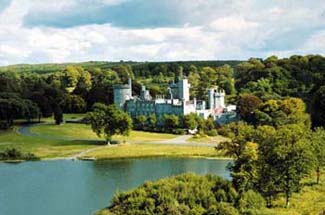
Photos courtesy of Dromoland Castle
Newmarket-on-Fergus,
County Clare
Tel: ++353 (0)61 368 144
Hotel website
Reserve with Booking.com
74 rooms, including 12 junior suites (or staterooms), and 6 suites
Double rooms: from 268 euros
Staterooms and suites: from 489 euros
Open: all year
From Shannon Airport, follow N18 north toward Ennis.
On site: golf; tennis; fishing;
shooting; boating; bicycling;
spa
Nearby: horseback riding;
deep-sea fishing; Bunratty
Castle and Folk Park;
Cliffs of Moher.
Although substantial changes have been made to the original structure of Dromoland Castle, many touches from the past remain.
O’Brien ancestral portraits line the walls of the formal public rooms. Waterford crystal chandeliers, oak paneling, damask wall coverings, Georgian antiques, and thick carpets give an appropriate baronial atmosphere.
Comfortable sofas and chairs by the fireplace create a cozy spot to enjoy a cup of tea while relaxing with a good book.
Guest rooms in the old wing are the grandest with tall windows and huge four-poster beds. Several have fireplaces. Rooms in the newer wings are standard in design. Some guest rooms are done in floral patterns, others in subdued colors. Eight rooms are built into turrets, and room 206 has an exceptional view of the grounds. With a nod to the 21st century, guest rooms also have flat-screen TVs.
Well-prepared traditional cuisine, such as roast lamb and Irish smoked salmon, is served in a dining room looking out onto a lake. Lunch is served in the tower bar that was once Lord Inchiquin’s study.
![]() Golf academy
Golf academy